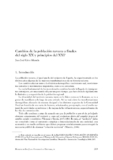Cambios de la población navarra a finales del siglo XX y principios del XXI
Fecha
2007Autor
Versión
Acceso abierto / Sarbide irekia
Tipo
Artículo / Artikulua
Impacto
|
|
nodoi-noplumx
|
Resumen
Este artículo presenta los cambios que han tenido
lugar entre 1991 y 2005 en la población navarra,
tanto en el nivel regional, como en el municipal.
En este lapso de tiempo se ha pasado del estancamiento
al crecimiento demográfico conocido más
elevado de la historia regional, al igual que sucede
en el conjunto de España. El agente principal de
este proceso ha sido la inmigración de extranjeros,
r ...
[++]
Este artículo presenta los cambios que han tenido
lugar entre 1991 y 2005 en la población navarra,
tanto en el nivel regional, como en el municipal.
En este lapso de tiempo se ha pasado del estancamiento
al crecimiento demográfico conocido más
elevado de la historia regional, al igual que sucede
en el conjunto de España. El agente principal de
este proceso ha sido la inmigración de extranjeros,
responsable del 90 % del crecimiento real regional
al final del período antes mencionado. Así, los
nuevos habitantes han provocado una reactivación
de la natalidad– poniendo fin al declive constante iniciado a fines de los años 1970– y el consecuente
aumento del crecimiento natural. En este tiempo,
a caballo entre el siglo XX y el XXI, se pasa de
una movilidad muy reducida de la población a una
aceleración de la misma con elevadas tasas migratorias,
fruto– sobre todo– de la llegada de extranjeros.
La procedencia de éstos es cada vez más variada,
si bien hay un predominio de los originarios
de Iberoamérica. La llegada de estas personas ha
ocasionado el retroceso del envejecimiento foral.
Todas las transformaciones mencionadas se
plasman en los distintos espacios de una manera
diferente, relacionada con la diversidad de la Comunidad
y con otros factores –entre los que destacan–
los avances que se van produciendo en las
infraestructuras viarias, facilitando la aceleración
del proceso suburbanizador en los espacios urbanos
más dinámicos e importantes, especialmente
del Área Metropolitana de Pamplona. [--]
This article presents the changes that have taken
place in the population of Navarre between 1991
and 2005, both at the regional and municipal levels.
This period has seen a change from the stagnation
of the population to the fastest-known demographic
increase in the region’s history, as has
happened throughout Spain. The main driver in
this process has been immigration by people from
other count ...
[++]
This article presents the changes that have taken
place in the population of Navarre between 1991
and 2005, both at the regional and municipal levels.
This period has seen a change from the stagnation
of the population to the fastest-known demographic
increase in the region’s history, as has
happened throughout Spain. The main driver in
this process has been immigration by people from
other countries, which accounts for 90% of real
regional growth at the end of the period in question.
New inhabitants have reactivated the birth
rate – putting an end to the constant decline that began at the end of the 1970s – and, consequently,
increased natural population growth. Over the period,
on the borderline between the 20th and 21st
centuries, very low population mobility has given
way to a higher rate, with a high level of immigration.
This is the result, above, all, of the arrival
of foreigners. Their origin is increasingly varied,
although the majority come from Latin America.
Furthermore, their arrival has slowed down the
rate of ageing of the population of the region.
All these transformations are reflected differently
in different places, and this has to do with
the diverse nature of Navarre and other factors,
among which the following stand outs: better road
communications, which accelerates the suburbanisation
of the larger and more dynamic population
centres, particularly the Metropolitan Area of the
city of Pamplona. [--]
Materias
Crecimiento real,
Movimientos naturales,
Inmigración,
Envejecimiento,
Suburbanización,
Navarra,
Real growth,
Natural movements,
Immigration,
Ageing,
Suburbanisation,
Navarre
Editor
Universidad Pública de Navarra / Nafarroako Unibertsitate Publikoa
Publicado en
HUARTE DE SAN JUAN. Geografía e Historia N. 14 / Geografìa eta Historia 14.Z. Pamplona: Universidad Pública de Navarra / Nafarroako Unibertsitate Publikoa, 2008. Págs. 269-296
Departamento
Universidad Pública de Navarra. Departamento de Geografía e Historia /
Nafarroako Unibertsitate Publikoa. Geografia eta Historia Saila





